mc²56 - Snapshot Offsets
Whenever a snapshot is recalled, either from the Snapshots or Cuelist display, it can be recalled with offset parameters.
For example, if you are running an opera where different soloists will perform on different nights, you can store a basic set of snapshots for the show, and then apply offset parameters for soloist A, soloist B, etc. without affecting the original snapshot values.
Any number of offsets can be applied, and can include a mixture of absolute and trim values:
- Use an absolute offset when you want a new static value throughout the cuelist – for example, to apply a new EQ setting for soloist B.
- Use a trim offset when you want to keep the relative changes from the snapshots within the cuelist – for example, to make soloist B's fader level +3dB louder throughout the show.
The active snapshot offsets are known as the Current Trim Set. This is a temporary buffer which you can update at any time allowing you to modify offset parameters during a show. For example, if soloist B sings louder than during rehearsal you can wish to adjust their trim offset!
You can also store offsets by saving the contents of the Current Trim Set into memories called Oversnaps. Each oversnap can store any number of offset parameters, and different combinations of oversnaps can be added to the Current Trim Set. This allows you to make any combination of offsets active – for example, to combine the offsets for soloist A with those for trombonist B.
Oversnaps are stored in the current snapshot folder within the active production. Oversnaps are written onto the user data flash card when you save or update a production. Note that you must use oversnaps to store and recall snapshot offset parameters. (The Current Trim Set is a temporary buffer which is saved in the system's warm start data to protect you from a system restart. However, if you clear the Current Trim Set, or change production, then any active snapshot offsets will be lost.)
Whilst snapshot offsets are designed for cuelist play out, active offsets are applied to any snapshot load. |
Snapshot offsets are managed from the Snapshot Trim Sets display.
The Snapshot Trim Sets Display
1. Open the Snapshot Trim Sets display on the Central GUI.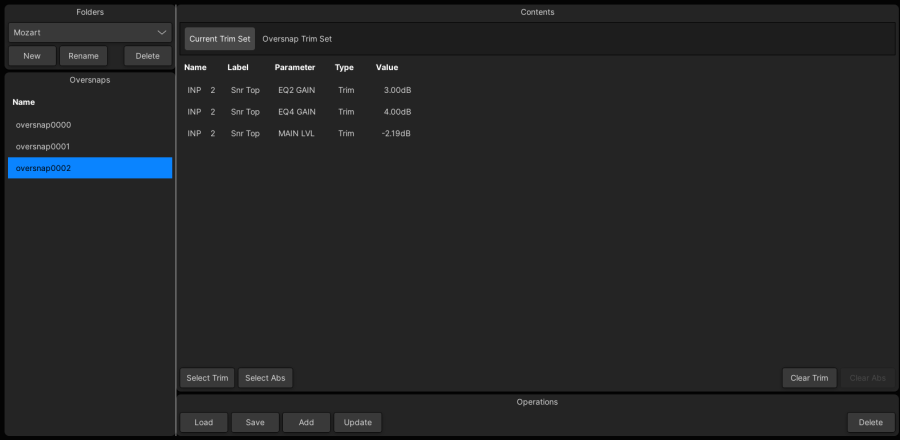
The display is divided into four areas:
- Folders – manages the snapshot folders stored in the current production.
- Oversnaps - lists the oversnaps stored in the selected folder.
- Contents - shows either the Current Trim Set or Oversnap Trim Set – click on the headings to toggle between the options:
- Current Trim Set - lists the active snapshot offset parameters. If the list is empty, then a snapshot will load with its original values. If the list contains offsets, then the offset values will be applied. Use the Current Trim Set to update the active offset parameters. This can be done live from the console, or by loading an oversnap.
- Oversnap Trim Set – lists the offset parameters which are stored in the selected oversnap. This allows you to view offset parameters before you load the oversnap.
Operations – buttons for managing Oversnaps: Load, Save, Add, Update and Delete.
During a live show, it is best to show the Current Trim Set in the Contents area. This way you can be sure that you are viewing the active offset parameters which will be applied to your next snapshot load.
First Steps
The Current Trim Set lists the active snapshot offset parameters. Offsets listed here are applied to all snapshot loads.
To update the list, you can either add offset parameters live from the console, or load a stored oversnap. Here we will look at adding offsets to the Current Trim Set from the console.The contents of the Current Trim Set are applied to all snapshot loads, including loads from the Snapshots and Cuelist displays.
When adding offsets, the console compares the current desk position to the value stored in the last loaded snapshot. Therefore, it's a good idea to start by loading the snapshot you want to use as a reference point for the comparison. (In our workflow, this will be the last snapshot played out from the cuelist.)
1. Load a snapshot - the console updates to the stored positions.
2. Open the Snapshot Trim Sets display on the Central GUI.
3. Click on Current Trim Set to view any active snapshot offsets.
The Current Trim Set will be empty, unless you have already been working with snapshot offsets.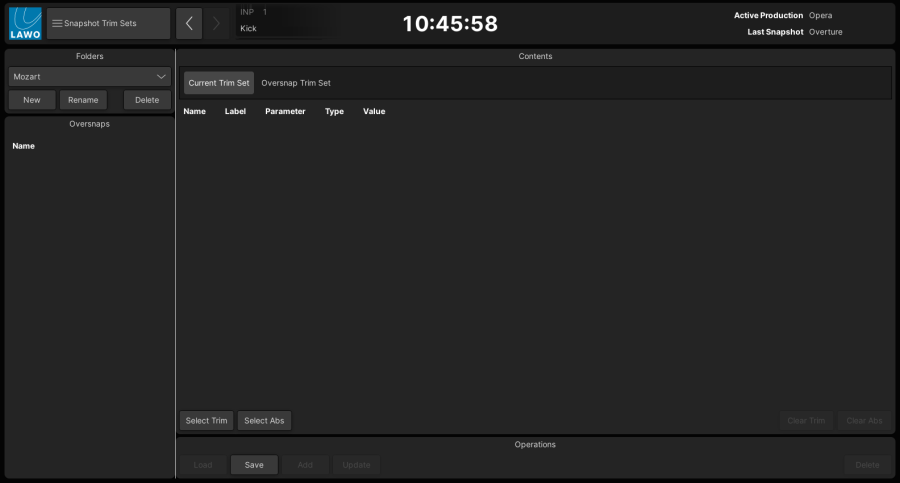
4. You can clear the Current Trim Set by clicking on the clear abs and clear trim buttons (lower right of the Contents area).
5. Now adjust the console parameters you wish to offset – for example, some fader levels and an EQ setting.
Let's assume that we want the new EQ setting to be static for the whole show (an absolute offset), but that the level changes should be relative (trim offsets).
6. Press ABS (under CHANNEL in the Central Control Section), or the on-screen Select Abs button, to activate the absolute offset parameter selection - the button flashes.
7. Assign the channel with the new EQ setting to the Central Control Section, by pressing its fader SEL button.
Any audio modules which have a different setting to that stored in the last loaded snapshot are displayed with green SEL buttons.
8. To add the new EQ setting to the Current Trim Set, press the green EQ SEL.
The SEL button turns red and each modified EQ parameter is added to the Current Trim Set as an absolute (ABS) offset on the Snapshot Trim Sets display: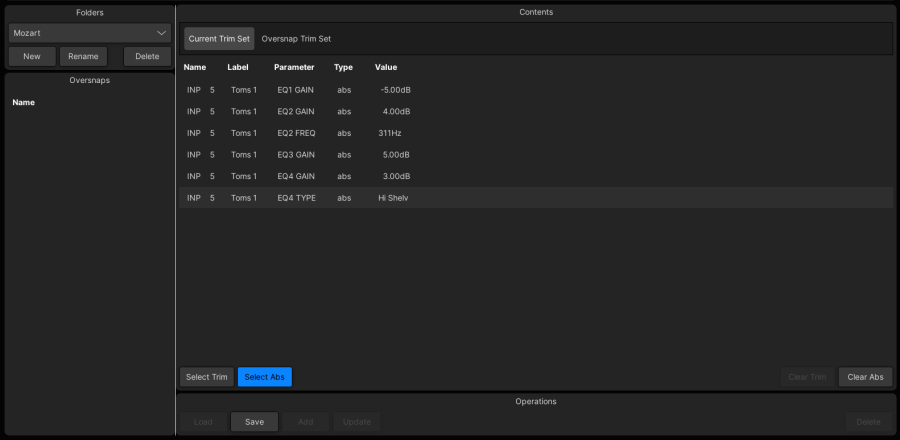
9. Now repeat the last three steps, but select the TRIM button or the on-screen Select Trim - the TRIM button flashes to show that you are now selecting trim offset parameters.
10. Assign one of the channels with a new fader level to the Central Control Section.
The fader SEL button lights (green) to indicate that the level has changed from that stored in the last loaded snapshot.
11. Press the green SEL button to add the trimmed fader level to the Current Trim Set.
The SEL button turns red and the trimmed fader level is added to the Current Trim Set on the Snapshot Trim Sets display.
12. Repeat for each new fader level, by assigning the channel to the Central Control Section and then pressing the green parameter SEL buttons.
As each offset parameter is selected, it is added to the Current Trim Set on the Snapshot Trim Sets display:
Note that the trim offset is the difference in level between the current fader position and the level stored in the last loaded snapshot – for example, if the snapshot loads a main fader level of -6dB, and you have moved the fader to +4dB, then the trim offset is +10dB.
13. When you have finished selecting offset parameters, turn off the SNAPSHOT OFFSET ABS and TRIM buttons, or Select Abs and Select Trim on the Snapshot Offsets display.
Note that the Current Trim Set is a temporary buffer and its contents are not saved other than in the system's warm start data. To save your offsets so that they can be recalled at a later date, you should save an oversnap.Recalling Snapshots with Offsets
As soon as you have added offset parameters to the Current Trim Set, these offsets are active. This means that any snapshot loaded from this point on, either from a cuelist or from a snapshot load, will have the Current Trim Set offsets applied.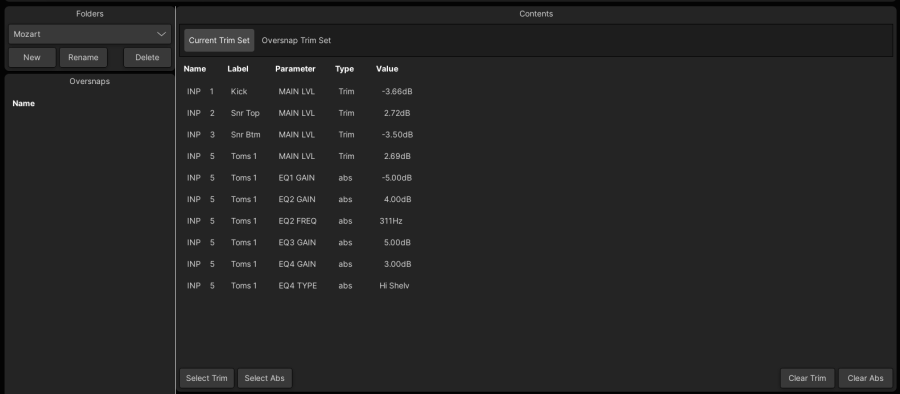
See Running a Cuelist and Loading a Snapshot for details.Clearing Snapshot Offsets
To disable snapshot offsets, you must clear the Current Trim Set.
1. Click on the clear abs button to clear all absolute snapshot offsets.
2. And click on clear trim to clear all trim offsets: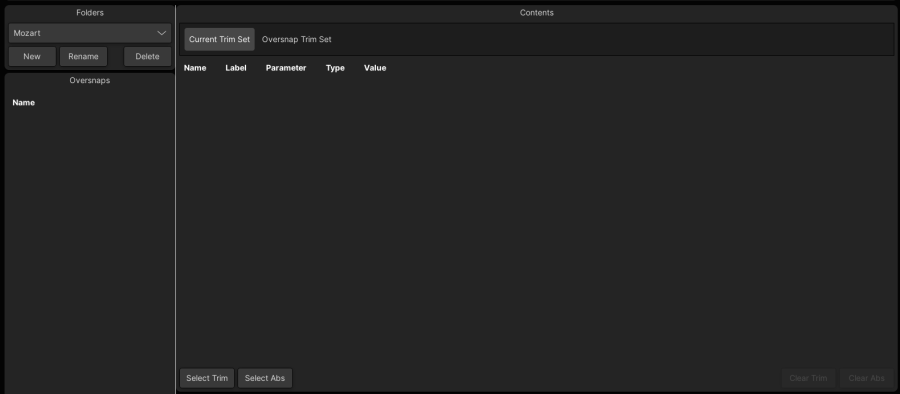
Once the Current Trim Set list is empty, snapshots will be loaded with their original values.
You can update the snapshot offsets in order to clear or modify a single offset parameter.Updating Snapshot Offsets
To update a snapshot offset - for example, if Soloist B sings louder than in rehearsal:
1. Press the TRIM button (under CHANNEL in the Central Control Section), or on-screen Select Trim.
2. Assign the Soloist B channel to the Central Control Section by pressing its fader SEL button.
The fader SEL button will be red as this parameter already has an active offset:
3. Adjust the fader level to the new setting - the parameter SEL button turns yellow.
4. Press the yellow parameter SEL button to confirm the new setting - the SEL button turns red and the trim offset updates within the Current Trim Set
5. Alternatively, to remove the trim offset altogether, press the red parameter SEL button - the SEL button returns to green and the Main LVL offset is removed from the Current Trim Set.
6. Remember to deselect the ABS and TRIM buttons (or on-screen Select Abs and Select Trim) when you have finished updating offsets. If you don't, and adjust a parameter with an active offset, then you will update the offset!Oversnaps
At any time, you can save the contents of the Current Trim Set into a memory called an Oversnap. This allows you to recall offset parameters at a later date.
Each oversnap can store any number of offset parameters. And, different combinations of oversnaps can be loaded back to the Current Trim Set. This allows you to combine snapshot offsets. For example, to combine the offsets for soloist A with those for trombonist B.
Oversnaps are stored in the current snapshot folder within the active production.Note that you must use oversnaps to store and recall snapshot offset parameters.
The Current Trim Set is a temporary buffer which is saved in the system's warm start data to protect you from a system restart. However, if you clear the Current Trim Set, or change production, then any active snapshot offsets will be lost.Oversnap Operations
Oversnaps are managed in a similar manner to snapshots.
Current Trim Set
Oversnaps- Name - click in the Name field to rename an oversnap.
Operations
- Load - replaces the contents of the Current Trim Set with the stored offsets.
- Save - saves the contents of the Current Trim Set into an oversnap.
- Add - adds the stored offsets to the existing parameters within the Current Trim Set. You can use this option to combine oversnaps.
- Update - updates the selected oversnap with the Current Trim Set.
Delete - deletes the selected oversnap.
- To check the contents of an oversnap:
1. Select the oversnap you wish to interrogate.
2. Click on Oversnap Trim Set (in the Contents area) - the display updates to show the contents of the selected oversnap.
Oversnap Trim Set
3. When you have finished interrogating stored oversnaps, it is a good idea to switch back to the Current Trim Set.
This way you can be sure that you are viewing the active offset parameters which will be applied to your next snapshot load.
Importing and Exporting Oversnaps
Oversnaps cannot be accessed individually from the File display, but they can be imported and exported by copying the snapshot folder:
1. Copy the snapshot folder containing your oversnaps to a USB interface or network drive using the File Export function from the File display.
2. Connect your USB interface or network drive to the destination console.
3. And import the snapshot folder into the current production using File Import from the File display.
If you now go to the Snapshot Trim Sets display and select the imported folder, you will see your oversnaps.